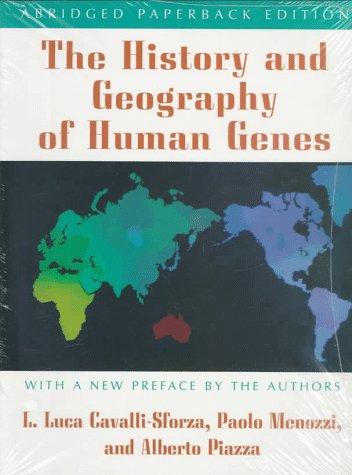THE HISTORY AND GEOGRAPHY OF HUMAN GENES. pdf
Par tucker bryon le lundi, juin 13 2016, 23:41 - Lien permanent
THE HISTORY AND GEOGRAPHY OF HUMAN GENES.. Luigi Luca Cavalli-Sforza

THE.HISTORY.AND.GEOGRAPHY.OF.HUMAN.GENES..pdf
ISBN: , | 0 pages | 3 Mb

THE HISTORY AND GEOGRAPHY OF HUMAN GENES. Luigi Luca Cavalli-Sforza
Publisher: Princeton Univ. Press,
The Cambridge ancienty history, 2nd Ed. In Steve Olson's book, Mapping Human History, page 133, he describes the discovery of fossils dating back 10,000 years, representing the remains of the Jomon people, a group whose facial features more closely resemble those of . Of expansion to the coastline, perhaps that of the Sea of Japan, but also father along the Pacific Coast", The History and Geography of Human Genes (Princeton University Press 1994 ISBN 0691087504) 253 Retrieved August 22, 2007. Cavalli-Sforza LL, Menozzi P, Piazza A. Cavalli-Sforza's "The History and Geography of Human Genes", written with Paolo Menozzi and Alberto Piazza (Princeton University Press, 1994), is still considered the best overview of genetic diversity in humans. Pelasgi - Used Books Find Races Of Mankind” : Grecian Race: Hellenes. Cavalli-Sforza, despite being a raging leftist, has done amazing work in genetics, and his book The History and Geography of Human Genes is great, though it is not for the laymen. Cambridge University Press; 1991. Princeton: Princeton University Press; 1994. The history and geography of human genes. The History and Geography of Human Genes: (Abridged paperback edition). And Languages, the new book by Professor Luigi Luca. The genetic distance from the Danish to the Irish is 1.0. A composite map of human genetic variation appeared on the cover of Cavalli-Sforza's tome The History and Geography of Human Genes (1994). I was wondering if any linguistic trace of this migration exists in any Australian language. Step out a little farther from the Isles, and using Cavalli-Sforza's genetic distance charts from his History and Geography of Human Genes, one sees distance widening.